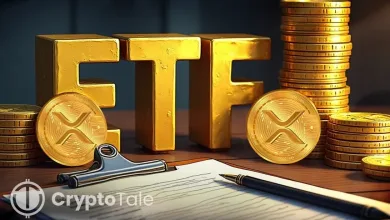Key Crypto Events Poised To Reshape The Industry In 2025

The final two months of 2025 could prove pivotal for the digital‑asset market. Regulatory agencies are catching up after an unprecedented U.S. government shutdown, and new exchange‑traded funds (ETFs) tied to lesser‑known cryptocurrencies are lined up for approval.
Federal Reserve policy decisions could drastically change the supply of liquidity. Alongside these macro drivers, institutional players are pushing deeper into tokenization and deposit tokens, while regulators are becoming more vocal about the risks in merging traditional finance with blockchain. The convergence of policy, projections, and products is creating both opportunity and risk for investors.
Government Reopening Restores Momentum for Crypto Regulation
On 12 November 2025, the longest U.S. federal government shutdown in history ended when President Donald Trump signed a funding bill that reopened government agencies. The 43‑day standoff had stalled key functions of the Securities and Exchange Commission (SEC) and Commodity Futures Trading Commission.
With the funding law extending operations through 30 January 2026, suspended staff returned to work, and regulators regained the ability to review a backlog of crypto‑related filings. The absence of regular economic data releases during the shutdown had also complicated Federal Reserve decision‑making, prompting Chair Jerome Powell to call the situation “driving in the fog”. The restoration of government services should therefore improve the data environment ahead of the December Federal Open Market Committee (FOMC) meeting and help the SEC resume normal operations.
Crypto‑focused bodies such as the SEC and the Commodity Futures Trading Commission can now restart the review process for dozens of pending exchange‑traded products. Before the shutdown, the SEC had adopted “generic listing standards” that shortened the review period for new crypto ETFs to 75 days, down from as much as 270 days. More than 130 crypto ETF applications are pending SEC review, and analysts expect the wave of approvals to begin in late 2025.
Related: How MiCA Is Reshaping Europe’s Crypto Landscape in 2025
Altcoin ETFs Poised to Broaden Investor Access
New standards speed approvals
The SEC’s new listing standards allow altcoin ETFs to come to market more quickly provided the underlying token trades on a regulated market or has a sufficiently liquid futures market. Before these reforms, U.S. ETFs were limited to bitcoin and ether; 21 spot crypto ETFs had launched by September 2025.
Analysts now expect the first products tied to cryptocurrencies such as Solana and XRP to debut by November 2025. Because the SEC eliminated the need for case‑by‑case approval, firms meeting the new criteria can expect their ETFs to become effective automatically within the shortened review window.
XRP and other altcoins line up
Investor attention is fixed on a handful of altcoins seen as leading candidates for the next wave of products. XRP, Solana, Cardano, Polkadot, and Hedera stand out among the 130‑plus applications awaiting review. Under the generic rules, approval odds for an XRP spot ETF are “above ninety percent,” and decisions on these first altcoin funds are expected late in 2025.
Excitement around XRP intensified in mid‑November after Canary Capital submitted a Form 8‑A registration statement with the SEC, the final step before listing. Reportedly, Nasdaq approved the listing for the Canary XRP ETF under the ticker symbol XRPC, paving the way for the first U.S. spot XRP fund to start trading. Bloomberg ETF analyst Eric Balchunas said the fund might begin trading as early as the week following the filing. The product’s launch could set the tone for other altcoin ETFs pending SEC approval.
Bitcoin Cycle Peak and Implications for Altcoins
Analysts foresee a late‑2025 peak
Many market watchers believe Bitcoin remains in a four‑year cycle tied to its roughly quadrennial halving events. Digital asset analyst Benjamin Cowen told that historical patterns suggest Bitcoin’s next major cycle peak will likely occur in the fourth quarter of 2025.
Cowen noted that in previous cycles—2013, 2017, and 2021—Bitcoin reached its highs late in the year following a U.S. presidential election. If that pattern holds, he expects a downturn in 2026, consistent with midterm‑year market corrections. The forecast implies that investors may see elevated volatility in the months ahead, with opportunities for rotation into undervalued tokens during the approach to the peak.
Another analysis from ARK Invest’s David Puell underscores the cyclicality of Bitcoin’s performance. After April 2024’s halving reduced the block reward from 6.25 to 3.125 bitcoin, ARK observed that the token’s price had already increased 41% by mid‑November 2024 but still lagged previous post‑halving rallies. Puell argued that if Bitcoin’s price continues to follow the average pattern of the prior two cycles, it could rise to around $243,000 within about 880 days from the November 2021 cycle low. Although this prediction predates 2025, it illustrates how long‑term cycle analyses support the thesis that a late‑2025 peak may be ahead.
Altcoins face a mature market
The prospect of a Bitcoin peak brings mixed implications for altcoins. Analysts from 21Shares observed that despite Bitcoin surging to record highs in early 2025, an anticipated “altcoin season” failed to materialize. Past cycles saw investors rotate capital from Bitcoin into smaller tokens once Bitcoin cooled. In 2024–25, however, oversupply of tokens and muted demand combined with stronger regulation to keep altcoin prices subdued.
As a result, Bitcoin’s dominance remained high and altcoins struggled to gain momentum. The report stressed that altcoins could still thrive if they offer genuine utility, but investor scrutiny has risen and projects must demonstrate tangible value to attract capital.
Altcoin proponents note that a maturing market does not doom these tokens. Web3 entrepreneur Kamal Mokeddem argued that altcoins are evolving from speculative chips into growth‑marketing tools that accelerate the adoption of decentralized applications.
He predicted that tokens integrated with popular Web3 services could amass monetary premiums that rival those of Bitcoin or Ether. While this view remains speculative, it highlights the shifting narrative around altcoins: investors may increasingly evaluate tokens based on network usage and incentive structures rather than pure speculation.
Federal Reserve Policy: Liquidity Injection and Rate‑Cut Uncertainty
QT halt boosts liquidity
Monetary policy is another critical factor for digital‑asset markets. At its 29 October meeting, the Federal Reserve cut its policy rate by 0.25 percentage points to a target range of 3.75%–4.00% and announced it would stop shrinking its balance sheet on 1 December 2025. Instead of allowing up to $5 billion in Treasuries to mature without replacement, the Fed will roll over maturing bonds and reinvest proceeds from mortgage‑backed securities into Treasury bills.
Chair Jerome Powell said reserve levels had reached the point where further reductions risked tightening money market liquidity. The move effectively ends quantitative tightening (QT) after more than three years of balance‑sheet runoff and marks an inflection point for financial markets. Analysts expect that maintaining the balance sheet will inject liquidity into short‑term funding markets, potentially supporting risk assets like cryptocurrencies.
Some analysts believe the Fed may soon need to expand its holdings again to keep pace with economic growth. Capital Economics’ Paul Ashworth estimated that the Fed would have to purchase roughly $20 billion of Treasuries per month to maintain neutral reserve levels in a growing economy. Although the central bank framed its decision as technical, history shows that increased liquidity often correlates with speculative rallies across asset classes. Crypto investors will be watching whether the end of QT catalyzes a “risk‑on” environment reminiscent of previous quantitative easing cycles.
Related: Top Blockchain Trends to Watch in 2025: Why Are They Bigger?
December FOMC meeting brings rate‑cut debate
Despite the October rate cut, Powell signaled that a further reduction at the 9–10 December FOMC meeting was not guaranteed. He told reporters that policymakers faced “strongly differing views” about whether additional easing was appropriate. The absence of key economic data during the government shutdown forced the Fed to rely on private surveys and limited indicators, and Powell warned that a lack of clarity could prompt officials to “slow down”.
Financial markets reduced their expectations for a December cut, pricing the probability at roughly one-third. The caution reflects a policy divide: some officials, such as Fed Governor Stephen Miran, advocated for a deeper cut at the October meeting, while others, including Kansas City Fed President Jeffrey Schmid, preferred no change. This split suggests that any December decision will depend heavily on data released in the weeks following the government reopening.
Institutional Adoption, Tokenization and Deposit Tokens
Tokenization gains traction alongside new risks
Beyond ETFs and macro policy, institutions are exploring ways to blend blockchain technology with traditional finance. Tokenization involves representing conventional assets—such as bonds or funds—on a blockchain as digital tokens that can be traded and settled more efficiently.
The global securities watchdog IOSCO warned in a November report that tokenization could introduce new counterparty and legal risks, noting that investors may not always be clear whether they own the underlying asset or merely a digital representation.
IOSCO chair Tuang Lee Lim said that although adoption is limited, tokenization has the potential to reshape how financial assets are issued, traded and serviced. Regulators are therefore assessing the need for updated investor protections and disclosure requirements.
The interest in tokenization is nevertheless growing. Galaxy Digital’s head of tokenization, Thomas Cowan, stated at a New York conference that large financial institutions now recognize the benefits of issuing tokenized assets irrespective of Bitcoin’s price. He argued that, unlike earlier cycles when enthusiasm vanished during bear markets, tokenization now stands as a compelling technology on its own.
Deposit tokens and stablecoins enter the mainstream
One concrete example of tokenization’s advance is the launch of JPMorgan’s deposit token. On 12 November 2025, the bank began rolling out JPM Coin, a digital token representing claims on existing client deposits. The token settles transactions on Coinbase’s Base blockchain network within seconds, 24 hours a day.
Unlike stablecoins, deposit tokens are issued by regulated banks and can be interest‑bearing. JPMorgan tested the product with partners such as Mastercard, Coinbase, and B2C2 before launch and plans to expand the initiative by introducing a euro‑denominated version. Naveen Mallela, co‑head of the bank’s blockchain division, said deposit‑based products could offer institutions a “yield‑bearing” alternative to stablecoins.
JPMorgan’s initiative underscores how banks are adopting blockchain to improve settlement speed and liquidity management. Other large banks, including Bank of New York Mellon and HSBC, are also exploring deposit tokens. The combination of bank‑issued tokens and regulatory attention indicates that traditional finance and crypto are converging.
Regulatory Scrutiny and Market Dynamics
Regulators weigh new oversight on crypto treasuries
While tokenization and altcoin ETFs signal innovation, regulatory bodies are simultaneously tightening oversight on crypto‑related corporate actions. Japan’s financial authorities have begun examining whether companies that pivot their primary business models to holding large amounts of cryptocurrencies should face additional listing scrutiny.
Tokyo Stock Exchange operator, Japan Exchange Group, was considering applying backdoor‑listing rules and other audit requirements to firms that become “digital‑asset treasuries” after several such companies suffered steep share declines. The move would close a regulatory loophole through which companies can effectively list a vehicle for cryptocurrency holdings without undergoing the rigorous initial public offering process. Though aimed at protecting retail investors, such measures could dampen enthusiasm for corporate treasury strategies that rely heavily on bitcoin.
Regulators outside Japan are also focusing on potential market manipulation and liquidity risks in tokenized stocks and ETFs. IOSCO’s report noted that because tokenized assets may trade on blockchain platforms with different legal frameworks, investors might have fewer rights or recourse mechanisms. Enhanced disclosure rules and custodial oversight could become a necessity for tokenized products as they gain popularity.
Institutional diversification and stable altcoin holdings
At the same time, institutional investors are broadening their exposure beyond Bitcoin and Ether. Research from 21Shares highlighted that ETFs tied to Bitcoin and Ethereum attracted significant institutional capital in 2024–25, but these buyers typically hold positions for the long term, reducing daily liquidity in spot markets.
As a result, much of the capital that once rotated into altcoins via crypto‑native platforms is now parked in exchange‑traded products. This shift may explain why speculative altcoin rallies have been absent despite high levels of retail trading in meme tokens. Analysts suggest that altcoins with clear utility, such as those enabling decentralized finance or real‑world asset tokenization, could benefit when traditional investors seek diversification.
Related: Crypto ETFs Open Regulated Path for Digital Asset Investors
Outlook: Navigating a Make‑or‑Break Period
November and December will put crypto’s new structure to the test as policy, market cycles and products collide. With the U.S. government reopened, regulators can resume work on long-pending ETF applications, including altcoin funds such as XRP and Solana, which could deepen liquidity and broaden institutional access.
At the same time, analysts expect Bitcoin to move toward a cycle peak in late 2025, raising the odds of sharper volatility and renewed rotation into select altcoins.
The Fed’s halt of quantitative tightening and its December rate decision will shape dollar strength and risk appetite, while banks push ahead with tokenization and deposit tokens that link blockchains to existing payment rails.
For diversified portfolios, this period demands close attention to regulation, macro data and product launches, as these factors may decide whether crypto ends the year with renewed momentum or fresh caution.





